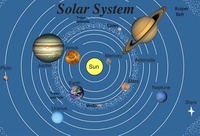
Solar System Data
Quiz
•
Science
•
6th Grade
•
Hard
+5
Standards-aligned

Charles Martinez
FREE Resource
25 questions
Show all answers
1.
MULTIPLE CHOICE QUESTION
30 sec • 1 pt

The images in the picture are particles of debris that are sometimes called shooting stars. They are
interplanetary dust.
asteroids
meteors.
comets.
2.
MULTIPLE CHOICE QUESTION
30 sec • 1 pt
Which (on average) takes the longest to orbit the sun (longest period)?
asteroid
comet
earth
mars
Tags
NGSS.MS-ESS1-2
3.
MULTIPLE CHOICE QUESTION
30 sec • 1 pt
Which of these planets has the coldest surface temperature?
Earth
Jupiter
Mars
Neptune
4.
MULTIPLE CHOICE QUESTION
30 sec • 1 pt
Which statement is true about the solar system?
Inner planets have more moons than outer planets have.
Inner planets are gaseous; outer planets are terrestrial.
Inner planets orbit at a lower rate than outer planets do.
Inner planets are more dense; outer planets are less dense.
Tags
NGSS.MS-ESS1-3
5.
MULTIPLE CHOICE QUESTION
30 sec • 1 pt

This is a description of a(n)
asteroid.
comet.
meteor.
star.
6.
MULTIPLE CHOICE QUESTION
30 sec • 1 pt
The tail of a comet usually faces
toward the Sun.
away from the Sun.
towards the Earth.
away from the Earth.
7.
MULTIPLE CHOICE QUESTION
30 sec • 1 pt

Venus has about the same mass as Earth and is about the same distance from the Sun. Yet Venus does not support life. An important difference between Earth and Venus is that Venus lacks
an atmosphere.
gravity and water.
a similar chemical composition.
water and moderate temperatures.
Tags
NGSS.MS-ESS2-4
Create a free account and access millions of resources
Similar Resources on Wayground

20 questions
Solar System and Space Exploration
Quiz
•
6th Grade

20 questions
Unit 1 Standard S6E1 Assessement Study Guide
Quiz
•
6th Grade

20 questions
Gas Giants Quiz
Quiz
•
6th Grade

20 questions
Solar System Review
Quiz
•
6th Grade

20 questions
Solar System
Quiz
•
6th Grade

20 questions
Outer Planet Characteristics
Quiz
•
6th Grade

20 questions
Astronomy 1
Quiz
•
6th Grade

20 questions
Solar System Quiz
Quiz
•
6th - 9th Grade
Popular Resources on Wayground

10 questions
Video Games
Quiz
•
6th - 12th Grade

20 questions
Brand Labels
Quiz
•
5th - 12th Grade

15 questions
Core 4 of Customer Service - Student Edition
Quiz
•
6th - 8th Grade

15 questions
What is Bullying?- Bullying Lesson Series 6-12
Lesson
•
11th Grade

25 questions
Multiplication Facts
Quiz
•
5th Grade

15 questions
Subtracting Integers
Quiz
•
7th Grade

22 questions
Adding Integers
Quiz
•
6th Grade

10 questions
Exploring Digital Citizenship Essentials
Interactive video
•
6th - 10th Grade
Discover more resources for Science

20 questions
Distance Time Graphs
Quiz
•
6th - 8th Grade

10 questions
Exploring Newton's Laws of Motion
Interactive video
•
6th - 10th Grade

17 questions
Thermal Energy Transfer
Lesson
•
6th - 8th Grade

20 questions
Physical and Chemical Changes
Quiz
•
6th Grade

10 questions
Exploring Chemical and Physical Changes
Interactive video
•
6th - 10th Grade

22 questions
Metals, nonmetals, metalloids
Quiz
•
6th Grade

15 questions
Pure Substances and Mixtures
Quiz
•
6th Grade

21 questions
States of Matter - Properties
Quiz
•
6th Grade

